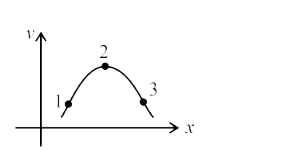The speed v of a particle moving along a straight line is given by a+bv2=x2 where x is its distance from the origin. The acceleration of the particle is
xb
xab
abx
ax
The correct Answer is:A
To find the acceleration of the particle moving along a straight line given the equation a+bv2=x2, we will follow these steps:
Step 1: Write down the given equation
The speed v of the particle is given by:
a+bv2=x2
Step 2: Differentiate both sides with respect to time t
To find the acceleration, we need to differentiate the entire equation with respect to time t:
ddt(a+bv2)=ddt(x2)
Step 3: Differentiate each term
- The derivative of a (a constant) is 0.
- For bv2, we apply the chain rule:
ddt(bv2)=b⋅2v⋅dvdt=2bvdvdt
- For x2, we again apply the chain rule:
ddt(x2)=2xdxdt=2xv
(since dxdt=v, the velocity).
Putting this all together, we have:
0+2bvdvdt=2xv
Step 4: Simplify the equation
We can simplify the equation:
2bvdvdt=2xv
Dividing both sides by 2v (assuming v≠0):
bdvdt=x
Step 5: Solve for acceleration
The acceleration a is defined as dvdt:
dvdt=xb
Thus, the acceleration of the particle is:
a=xb
Final Answer
The acceleration of the particle is:
xb
---
The speed v of the particle is given by:
a+bv2=x2
To find the acceleration, we need to differentiate the entire equation with respect to time t:
ddt(a+bv2)=ddt(x2)
- The derivative of a (a constant) is 0.
- For bv2, we apply the chain rule:
ddt(bv2)=b⋅2v⋅dvdt=2bvdvdt
- For x2, we again apply the chain rule:
ddt(x2)=2xdxdt=2xv
(since dxdt=v, the velocity).
0+2bvdvdt=2xv
We can simplify the equation:
2bvdvdt=2xv
Dividing both sides by 2v (assuming v≠0):
bdvdt=x
The acceleration a is defined as dvdt:
dvdt=xb
a=xb
The acceleration of the particle is:
xb
Topper's Solved these Questions
- DERIVATIVE AS A RATE MEASURER Book:OBJECTIVE RD SHARMA ENGLISHChapter:DERIVATIVE AS A RATE MEASURER Exercise:Section I - Solved Mcqs
Explore 27 Videos
- DERIVATIVE AS A RATE MEASURER Book:OBJECTIVE RD SHARMA ENGLISHChapter:DERIVATIVE AS A RATE MEASURER Exercise:Exercise
Explore 26 Videos
- DEFINITE INTEGRALSBook:OBJECTIVE RD SHARMA ENGLISHChapter:DEFINITE INTEGRALSExercise:Chapter Test 2
Explore 56 Videos
- DIFFERENTIAL EQUATIONSBook:OBJECTIVE RD SHARMA ENGLISHChapter:DIFFERENTIAL EQUATIONSExercise:Chapter Test
Explore 30 Videos
Similar Questions
The speed(v) of a particle moving along a straight line is given by v=(t2+3t−4 where v is in m/s and t in seconds. Find time t at which the particle will momentarily come to rest.
View SolutionThe displacement x of a particle at time t along a straight line is given by x=α−βt+γt2. The acceleraion of the particle is
View SolutionThe distance traversed by a particle moving along a straight lne is given by x=180t+50t2 metre. The acceleration of the particle is
View SolutionIf a particle is moving along straight line with increasing speed, then
View SolutionThe speed v of a particle moving along a straight line, when it is at a distance (x) from a fixed point of the line is given by v2=108−9x2 (all equation are in CGS units):
View SolutionThe velocity 'v' of a particle moving along straight line is given in terms of time t as v=3(t2−t) where t is in seconds and v is in m/s.
The distance travelled by particle from t=0 to t=2seconds is :
View SolutionThe displacement x of a particle along a straight line at time t is given by x=a0+a1t+a2t2. The acceleration of the particle is
View SolutionThe acceleration of a particle moving along a straight line at any time t is given by a = 4 - 2v, where v is the speed of particle at any time t The maximum velocity is
View SolutionThe v-x graph for a particle moving along a straight line is shown in the figure. At which of the points marked, the acceleration is negative?

View SolutionThe speed v of a particle moving along a straight line. When it is at distance x from a fixed point on the line is v2=144−9x2. Select the correct alternatives
View Solution